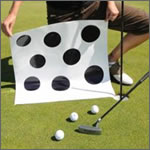A new study demonstrates that imagination can have a direct effect on our perception of the world. This may help explain why more accomplished sports-players describe perceiving the ball, or target such as a golf cup, as bigger.
Jessica K. Witt, an assistant professor at Purdue University, found that golfers who play well are more likely to actually see a bigger hole.
Witt’s research team conducted three experiments. In the first, 46 golfers were asked to estimate the size of the hole after they played a round of golf. The diameter of a golf hole is 10.8 centimeters. The golfers selected one of nine black holes from a poster that ranged in size from 9-13 centimeters. Those who selected larger holes were the same players who had better scores on the course that day.
These findings matched up with previous research by Witt and Proffitt which found that people who were successful at hitting a ball remembered it as larger.
The question all golfers, and other athletes, will be asking is: how can I change my perception to increase my performance? Unfortunately this study can’t tell us what causes what. The big question is whether playing better causes the hole to appear larger, or imagining the hole is larger causes better play.
Imagination instantly influences perception
Although Witt’s research doesn’t tell us, a second new study does show how easy it is for imagination to directly influence our perception of the world. Joel Pearson from Vanderbilt University and colleagues found that people’s imagination influences both how they currently see something and how they see it in the future.
In their experiment participants imagined a pattern of either vertical or horizontal stripes. They were then presented with a horizontal pattern to one eye and a vertical pattern to the other eye. The effects of binocular rivalry mean that most people see the two patterns alternating. But subjects in this experiment were more likely to see the pattern they had been imagining.
“You might think you need to imagine something 10 times or 100 times before it has an impact,” says Frank Tong, associate professor of psychology and co-author of the study. “Our results show that even a single instance of imagery can tilt how you see the world one way or another, dramatically, if the conditions are right.”
Pearson and colleagues found strong individual differences in the influence of imagination on perception. While imagination influenced everyone’s perception, some people were much more influenced than others. This might suggest that some sports-people have a better developed talent for effective visualisation than others.

